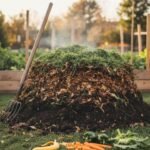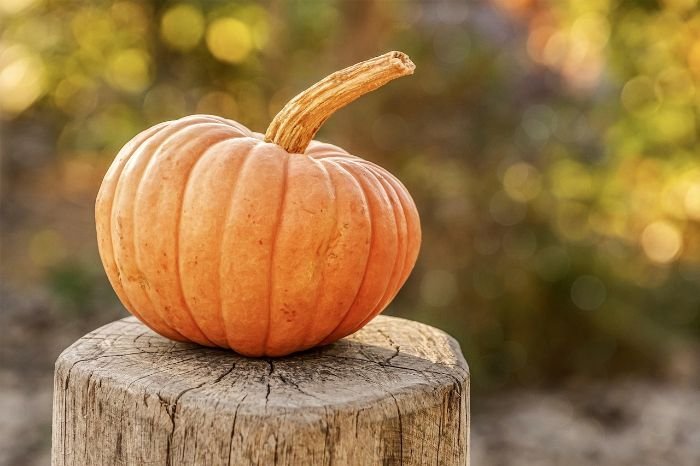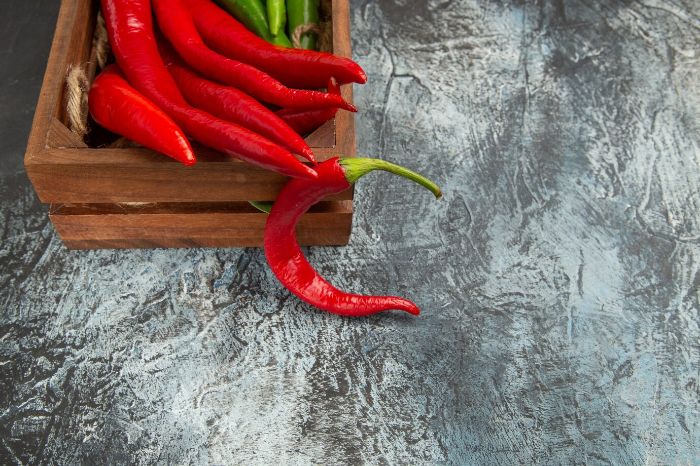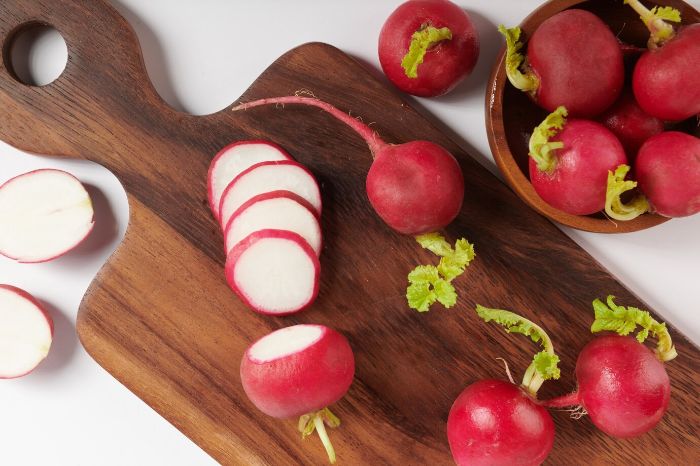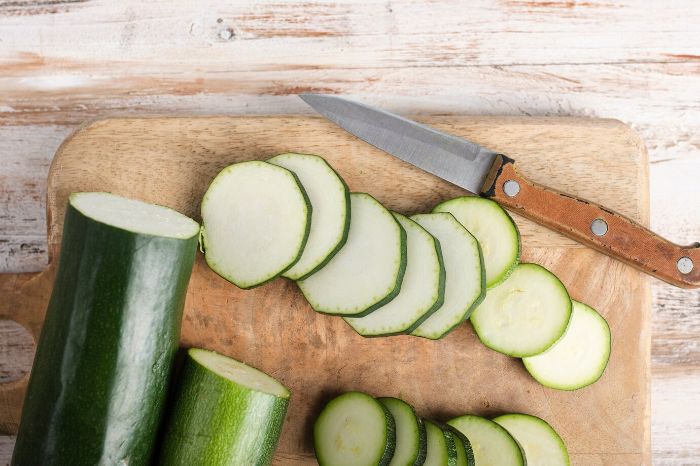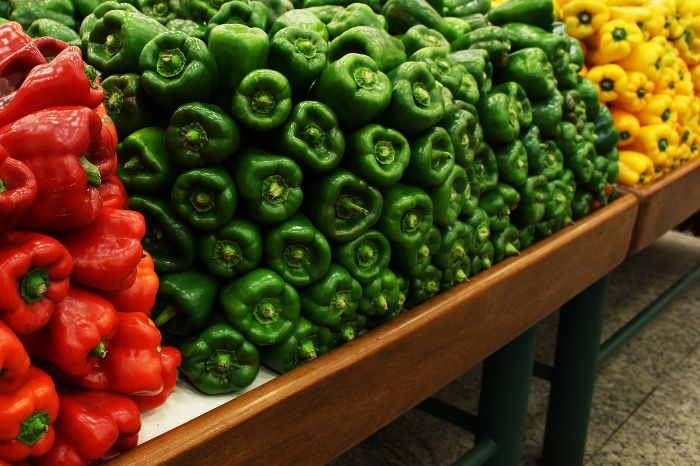Have you ever thought about how pumpkins start from tiny seeds to big, colorful fruits by fall? What magic makes them grow so well? Well, we’ll show you the steps of pumpkin growth. This way, you can have a great harvest and lots of pumpkins.
We’re here to guide you through pumpkin growth. We’ll start with planting and then move to when they sprout and start to flower. Finally, they grow big and turn into pumpkins. Along the way, we’ll share tips to help you out.
Key Takeaways:
- Understanding the stages of pumpkin growth is crucial for a successful harvest.
- From planting and germination to maturation, each stage requires specific care and attention.
- Proper fertilizing, watering, and pest management techniques are essential for the healthy growth of pumpkins.
- Pollination plays a vital role in pumpkin development and fruit set.
- By planning ahead and saving seeds, you can ensure a bountiful pumpkin harvest year after year.
Table of Contents
About Pumpkin Growth Stages
Welcome to the wonderful world of pumpkin growth stages! Knowing how pumpkins grow is vital for their care. We will look at why pumpkin growth is important and the stages they go through. Get ready to learn all about the amazing journey of pumpkin growth.
The Importance of Understanding Pumpkin Growth
It is essential to know the stages of pumpkin growth for healthy pumpkins. You can adjust your gardening to what the pumpkins need at each stage. This lets you create the best conditions for them and deal with problems like bugs or diseases. Also, knowing about pumpkin growth helps you choose the right times for planting, watering, feeding, and picking. Learning about pumpkin stages is key to a great harvest.
Overview of Pumpkin Development
Pumpkin growth starts from a tiny seed and grows into a big fruit. The process includes planting, sprouting, growing vines, flowering, and finally ripe fruit. At each step, the plant changes a lot, making leaves, vines, and blooms. By understanding pumpkin growth, you will see the amazing process these plants go through.
Planting and Germination
We’re here to help you with planting and growing pumpkins. We’ll show you how to pick the best seeds, prep the ground, and plant correctly. This will help make sure you get lots of pumpkins.
Selecting the Right Pumpkin Varieties
Choosing the right pumpkins is key. Think about if you want them for looks or to eat, how much space you have, and your weather. There are many types, like large carving pumpkins, small ones, or ones for pies. Do some looking around to find what’s best for you.
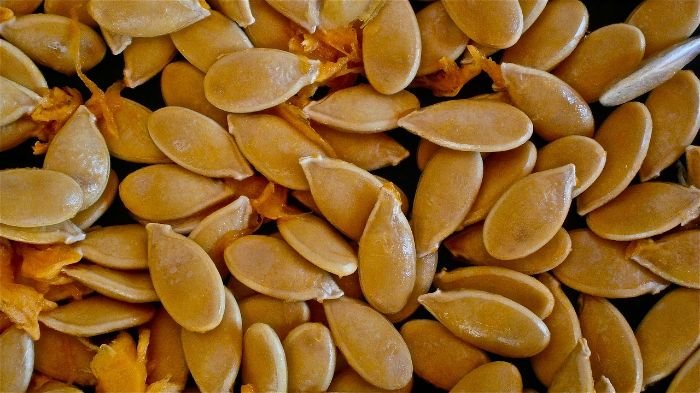
Soil Preparation and Planting Techniques
Getting the soil ready is important. Pumpkins like soil that drains well and has lots of nutrients. First, get rid of weeds and make the soil soft. Add compost or manure to make it better.
You can plant seeds in the ground or start them indoors. If in the ground, make some small hills for planting on. This helps water drain away.
If you start seeds inside, use special pots. This makes moving them easier. Make sure they stay warm and get enough light.
Optimal Conditions for Germination
Pumpkins need the right conditions to start growing. The soil should be warm, between 75-85°F. It should be kept moist, but not too wet, to avoid seed rot.
Seeds usually sprout in 5 to 10 days. After they sprout, they need lots of sun and regular water. This makes them grow well.
Remember, by setting things up right at the start, you can grow great pumpkins. Think about the type of pumpkins, the soil, how you plant, and the growing conditions. Good luck with your pumpkin patch!
Early Growth Stage
At the start, pumpkin plants develop seedlings and first true leaves. This stage is key for future plant growth.
Seedlings change from cotyledon leaves to true leaves gradually. True leaves look like mature pumpkin leaves.
Giving enough water is crucial for pumpkin seedlings. The soil should be moist but not too wet.
These seedlings need the right nutrients. Balanced fertilizer supports their health and growth.
Damping off is a common early issue. It’s a fungal disease that wilts and kills seedlings. Good airflow and proper soil can prevent this.
Pests like aphids or spider mites might attack your seedlings. Check often and deal with pests early to keep your plants healthy.
Vining Stage
As pumpkins grow, they develop vines and leaves in the vining stage. This stage is important for the plant to grow strong. And it helps the pumpkins to become healthy. Knowing how to grow and guide these vines is key to growing great pumpkins.
Formation of Vines and Leaves
In the vining stage, pumpkin plants grow a lot. Vines and leaves quickly spread out. The main stem makes vines that go out and cover a lot of space. And new leaves appear along these vines.
Leaves are crucial for making food for the plant from sunlight. They have a lobed shape to catch a lot of light. This helps the plant grow and make pumpkins.
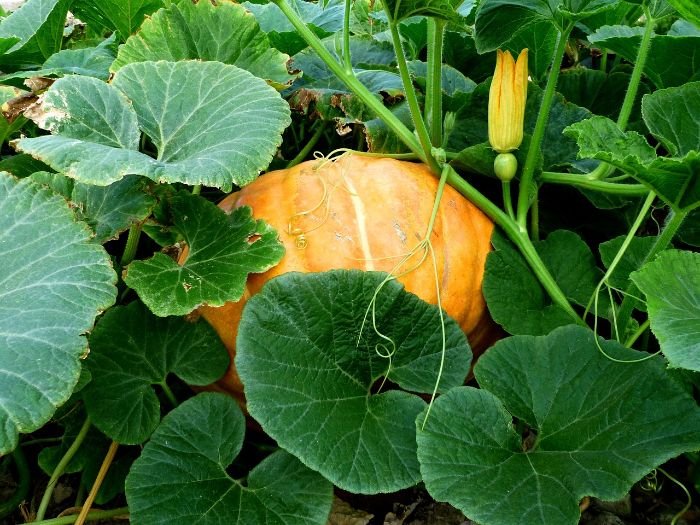
Training Vines for Optimal Growth
It’s key to guide pumpkin vines for the best growth. This helps with air flow and disease prevention. And it makes it easier to manage the plant in your garden.
Guiding the vines along a trellis is a good way to train them. This keeps them off the ground, safe from harm. It also saves space and makes picking the pumpkins easier.
Trimming is also good for the vines. It helps them focus on growing fruit. Pruning also helps with air flow. Just be careful to not cut too many leaves, as they are important.
Managing Space in Your Garden
Pumpkin vines need a lot of room. If you don’t have enough space, try planting in containers or up on trellises. This can keep the vines from spreading too much.
Using good garden care can also save space and help the plants grow well. Things like weeding, mulching, and giving plants enough space are all important in a garden.
Flowering Stage
At the flowering stage, pumpkins grow male and female flowers. This phase is important for fruit development. Knowing about flowers and how they are pollinated can help you get more pumpkins.
Identifying Male and Female Flowers
Male flowers make pollen, and female flowers make the pumpkin part. It’s key to tell them apart for good pollination.
Male flowers are on long stems with one flower. Female flowers have short stems and a small pumpkin part at the base.
By seeing these differences, you can spot who’s who in your pumpkin area.
Pollination Process and Its Importance
Pollination moves pollen from male flowers to female flowers, helping pumpkins grow. Bees and others help this process happen.
Without pollination, female flowers won’t turn into pumpkins. Knowing about pollination helps you support it, ensuring pumpkins in your garden.
Encouraging Pollination for Better Yield
To get more pumpkins, do these things in your garden:
- Plant flowers that bees like near your pumpkins. This attracts pollinators.
- Use less pesticide to not hurt the pollinators. This helps with pollination.
- If you don’t see bees, you can pollinate by hand. Use a small brush to move pollen.
- Keep your plants healthy by giving them the right sun, water, and food. Healthy plants attract more pollinators.
These steps can help you get more pumpkins by supporting pollination.
Fruit Set and Development
After bees pollinate them, pumpkins grow from flowers to young fruits. This stage is important for their growth. Many things, like sunshine and food, help them become big, round, and orange pumpkins.
Transition from Flowers to Young Pumpkins
When a flower is pollinated, it turns into a small pumpkin. This is the start of pumpkin growth. The little pumpkin gets bigger and turns into the shape and color we know.
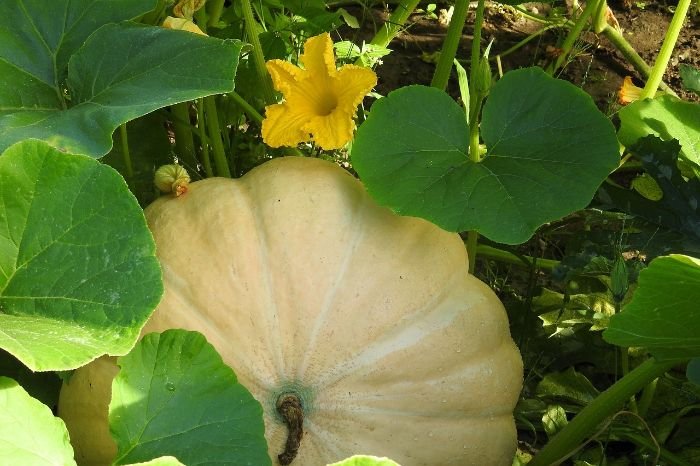
Factors Affecting Fruit Development
Pumpkins need a lot of sun to grow well. Make sure your pumpkin area gets 6-8 hours of sunlight every day.
Food is also key for pumpkin growth. Use a fertilizer with nitrogen, phosphorus, and potassium. The right nutrients help a pumpkin grow big and healthy.
Don’t forget about water. Pumpkins need regular water, but the soil should not get too wet. Too much water can cause problems.
Keeping pests away is important for good pumpkin health. Check your pumpkins often and use natural ways to stop pests and diseases.
Tips for Ensuring Healthy Fruit Growth
- Support the young pumpkins so they don’t touch the ground. Use slings or mesh netting.
- Check your pumpkins often for any problems. Solve them quickly to keep your pumpkins healthy.
- If there are too many pumpkins, take some away. This helps the others grow well.
- Water your pumpkin plants regularly to keep the soil moist. Consistent water is important.
- Don’t prune too much while the pumpkins are growing. This can hurt the pumpkin plants.
Learning about how pumpkins grow and what they need can help you grow healthy pumpkins. We will talk more about pumpkin growth in the next section, including how to tell if a pumpkin is ready to harvest.
Maturation Stage
It’s important to watch your pumpkins as they mature. Look for signs of readiness such as color and hardness. Check the stem and the pumpkin’s size too.
- Color – Mature pumpkins are very colorful. This means bright orange for orange types. Other types will show their own special color when fully ripe.
- Hardness – Touch the pumpkin skin to check if it’s firm. If it doesn’t give when you press it, it’s probably ready to pick.
- Fully Developed Stem – The pumpkin’s stem should be dry. It should break off the vine easily. Just give it a light twist or pull.
- Size – The right size can also tell you if a pumpkin is ready. Know how big your type of pumpkin should get. Harvest ones that are in the correct size range.
Helping your pumpkins grow well is key. They need proper care to reach their best. Here’s how to take care of them:
Best Practices for Supporting Growing Pumpkins:
- Regular Watering – Water your pumpkins well. This is especially true when it’s dry out. It helps the fruit grow and stops the plants from wilting.
- Weed Control – Keep the area around the pumpkins clean. Weeds use up the water and nutrients that pumpkins need.
- Fertilization – Give your pumpkins the right food. Use fertilizer as directed. This helps them grow strong and healthy.
- Pest and Disease Management – Keep an eye out for pests and diseases. If you see any, act fast. Use natural ways to stop them from harming your pumpkins.
Even with perfect care, problems might come up. Knowing how to deal with these problems is important. This knowledge can ensure you get a good pumpkin harvest.
Common Problems During Maturation:
Poor Fruit Set – Not enough pollination can lead to poor fruit. Help the process by attracting bees. You might need to hand-pollinate too.
Rot and Decay – Too much moisture or bad storage can make pumpkins rot. Harvest them when they are dry. Then, keep them cool and dry to avoid fungus.
Pest Damage – Problems like squash bugs can harm your pumpkins. Check often for pests. Take steps to keep the pests under control.
Watch for signs that your pumpkins are ripe. Take good care of your plants. And be ready to deal with any issues. This can lead to a better pumpkin harvest.
Harvesting Pumpkins
Harvesting pumpkins at the right time is key to keeping their quality. To check if they are ready, look for these signs:
- Pumpkins should be a deep, vibrant color. They’re usually rich orange, but might be white or green.
- The stem should be dry and brown. A rotting stem means the pumpkin is too old.
- The skin should be tough. If it’s soft, the pumpkin is not ready yet.
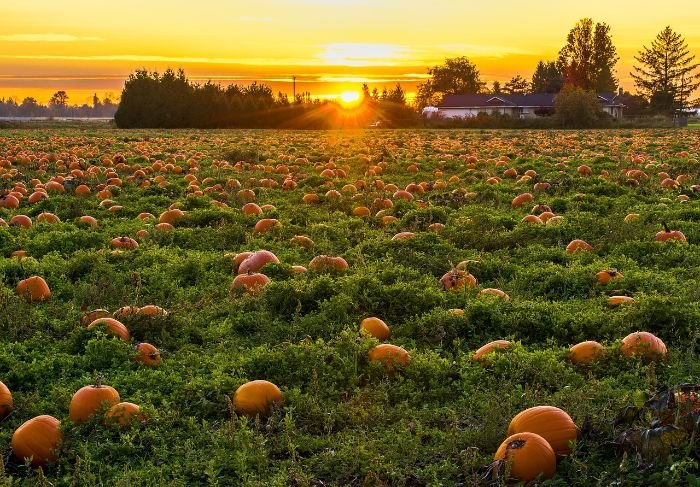
When you know it’s time, harvest carefully. Use the right tools and avoid damage by not twisting them off.
- Use scissors or a knife to cut the stem. Do this about 1-2 inches above the pumpkin.
- Handle them gently to avoid any marks or bruises.
Next, be careful after picking. Remove any dirt lightly. Don’t wash them because they might spoil faster.
Keep your pumpkins in a cool, dry spot, like a basement. Avoid heat and sunlight.
By doing all this the right way, you can have great pumpkins all fall.
Tips for Growing Large, Healthy Pumpkins
Want big, healthy pumpkins? You need the right fertilizer, water, and ways to fight bugs and diseases. Follow these steps for a better pumpkin harvest.
Fertilizing Strategies for Size and Health
Fertilize your pumpkin plants well. To make them big and healthy, keep these steps in mind:
- Choose a fertilizer high in potassium for the best fruit.
- Follow the package directions when applying it to evenly feed the plants.
- Think about using organic options like compost or aged manure for slow nutrient release.
- Watch how your plants are doing. Change your fertilizing plan as needed.
Watering Techniques for Optimal Growth
Good watering keeps your pumpkins growing strong. Use these tips to water them just right:
- Water deep but not too often to help roots grow down.
- Watering in the morning can help leaves dry before the night, which fights disease.
- Soaker hoses are great to water at the roots and not waste water.
- Always check the soil for moisture and adjust how much you water based on the weather.
Pest and Disease Management
Don’t let pests and diseases ruin your pumpkins. Here’s how to keep them at bay:
- Look closely at your plants often to catch pests early.
- Choose organic bug sprays so you don’t harm helpful insects.
- Keep your garden tidy by picking up plant leftovers and pulling weeds.
- Change where you grow your pumpkins every year to stop pests and diseases from staying.
Follow these guidelines for better, bigger pumpkins. They’ll help your pumpkin patch thrive.
Preparing for the Fall Harvest
The fall harvest is coming. It’s time to plan and get the most from your pumpkins. With a bit of preparation, you can enjoy a fruitful harvest season.
Planning Your Harvest Activities
Having a plan is key before the harvest starts. Figure out how many pumpkins you’ll pick. This helps decide the work and time needed for picking.
Make a to-do list for tasks before harvest time. Pruning, weeding, and prepping the area are on the list. Ask friends or family to help for a fun and fast experience.
Don’t forget about where to keep and move your pumpkins. A dry, cool spot is best for storage to keep them fresh. If you’re selling or giving them away, think about transport or delivery early.
Creative Uses for Your Pumpkins
There are so many ways to use pumpkins, not just for making jack-o’-lanterns. Get creative with your pumpkin projects.
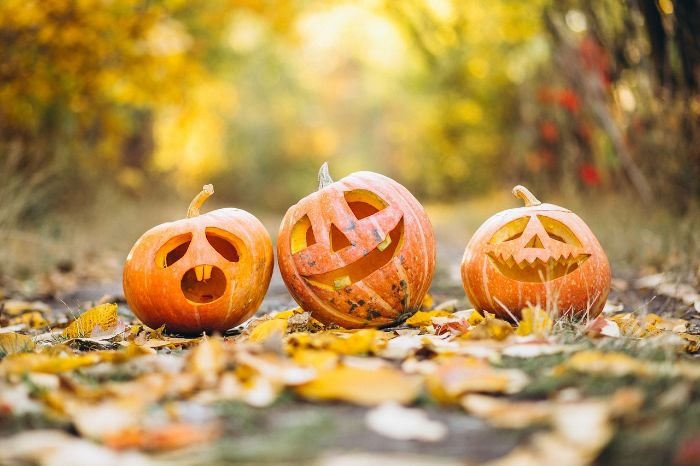
Add pumpkins to your home decor with wreaths or centerpieces. Or turn them into bowls for snacks or drinks at your fall parties.
Try cooking with pumpkins. Make things like pie, soup, or bread. These foods are tasty and good for you, celebrating the season’s tastes.
Saving Seeds for the Next Season
Want to grow pumpkins again next year? Saving seeds is a smart move. Here are some steps to save seeds successfully:
- Choose healthy, ripe pumpkins for their seeds.
- Take seeds out and clean off the pulp in a bowl of water.
- Gently rub the seeds to get rid of dirt and pulp.
- Wash the seeds and dry them on a paper towel.
- Keep the seeds in a cool, dry place in a sealed container until you’re ready to plant.
Labeling your saved seeds makes them easy to find later.
Plan your harvest, have fun with your pumpkins, and save seeds for later. Enjoy the fall season with pumpkins, turning them into special moments and treats.
Conclusion – Achieving a Bountiful Pumpkin Harvest
It’s vital to know the growth stages of pumpkins for a big harvest. This journey starts with planting and ends with picking. Every step needs attention and love. With the help of this guide, you can grow pumpkins well.
We talked about picking the best pumpkin types and soil prep. We also covered vine care and pollination. These steps are critical for your pumpkin’s success.
Creating the right conditions is key. Be sure your pumpkins get enough water and food. And keep pests and diseases away as best as you can. This care will keep your pumpkins healthy.
Getting ready for fall means thinking about fun pumpkin ideas. You can carve them, cook tasty dishes, or decorate your home. Remember to keep some seeds. This way, you can grow more pumpkins next year.
FAQ
Why is it important to understand pumpkin growth stages?
Knowing about pumpkin growth stages helps you get more pumpkins. You can take better care of your plants. This means a bigger harvest for you.
How do I select the right pumpkin varieties for planting?
Think about your climate and space when picking pumpkins. Look at what you want to do with them. Choose ones that fit your area and needs well.
What are the best practices for soil preparation and planting techniques?
First, get the soil ready by removing weeds and adding organic matter. Plant seeds the right way in the ground. Don’t forget that pumpkins need enough sun and water.
What are the optimal conditions for pumpkin seed germination?
Pumpkin seeds like warm soil and enough water. Keep the soil moist but not soaked. This helps the seeds to grow.
How can I manage space in my garden as pumpkin vines spread?
Vines need lots of space. Use trellises or let them grow in a certain area. Cut back vines that are too much. Support them well to keep them safe.
What factors affect fruit development in pumpkins?
Weather, water, sun, and how well the flowers get pollen matter a lot. Keep conditions stable and help with pollination. This is key for big, healthy pumpkins.
How can I tell if pumpkins are ready for harvest?
A ripe pumpkin is hard to scratch, has a deep color, and a dry stem. It should sound hollow when you tap it, too. These signs mean it’s time to pick it.
What are some common problems that may arise during pumpkin maturation?
Look out for pests, diseases, and bad weather. Check your pumpkins often for any issues. Act fast to stop a problem from getting worse.
What are some tips for growing large, healthy pumpkins?
Use a good plan with food and water for your pumpkins. Protect them from pests and diseases. This makes them big and strong.
